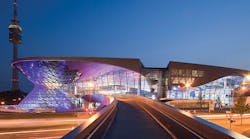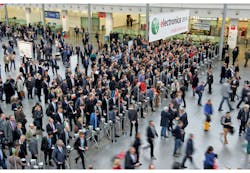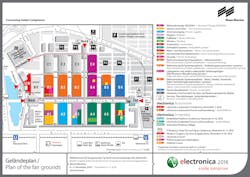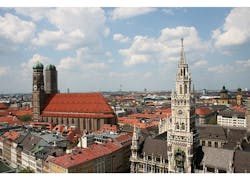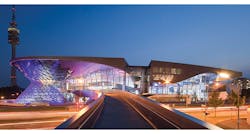Arguing is easy—just look at the constant bickering between our two major political parties. Agreeing on the best parts and systems for a design project is hard, though. Often, even after we’ve discovered precisely what specs a given part has and which characteristics are most important for the application at hand, the deciding differences can be marginally slim. Sometimes, the final outcome is based on a factor or factors we didn’t even think of at the outset of the project.
Finding a locale where you’re able to share ideas and ask technical questions of fellow engineers can be an invaluable asset as you weigh possible solutions. And there’s no better venue to do so than electronica, which started in Munich back in 1964 and has been held on a bi-annual basis ever since.
The show presents an unrivaled opportunity for electronics engineers, designers, purchasers, and researchers to catch up on the latest electronics technology. An estimated 75,000 will pass through the gates of Messe Munchen from November 8 through 11, making electronica the world’s largest business-to-business electronics trade fair.
Bigger than Ever
Electronics manufacturers usually view electronica as a barometer of industry trends, so the fact that the show is growing from 12 to 13 halls (Hall C4 will now be occupied) with exhibition space increasing from 133,000 to 143,000 square meters can be viewed as a solid affirmation of the health of the industry. It’s also a vivid display of supplier response to customer demand for accessible solutions to today’s design challenges.
This expansion has resulted in some hall assignment changes. The sectors for printed circuit boards (PCBs) and other circuit carriers, and electronic manufacturing services (EMS), will occupy two entire halls, i.e., B4 and C4. Power supplies now are the focus of exhibits in Halls A2 and A3 and electromechanics/system periphery is moving into Halls B2 and B3.
While statistics may be pliable, as Mark Twain noted, there is no getting around the fact that electronica is huge. Visitors will find more than 2,700 exhibitors from at least 50 countries around the world. Plus there’s a show guide resembling the Yellow Pages of a couple of decades ago (remember them?).
OMG, as the kids say.
But is it worth attending? Admittedly, electronica is a grind and no one ever gets to see every bit of the technology on display at the show. You may get blisters on your feet walking from a booth in one hall to another quite a distance away (there are “people movers” that can get you from one side of the venue to the other—see the the dotted lines on the map), you’ll suffer from jet lag in the beginning (go a day or two early if you can afford it), and you’re also likely to be really tired at the end. But to answer the question directly—yes, it’s worth the effort, particularly if you do business in Europe.
What’s more, in addition to ICs, PCBs, and systems, electronica exhibitors include manufacturers of power supplies, passives, connectors, and displays. Since there’s no equivalent single show in the U.S., you would have to attend several events in different locations here to view the breadth of electronics on display in Munich.
There’s another compelling reason to go. If you’re to continue to work to the high standards and competence demanded by the profession and your employer, it’s essential to keep professional knowledge and awareness up-to-date and develop the skill set needed to cope with continuing technological advances. The point is that you must treat your career as a dynamic thing that needs continuous upkeep and upgrading, and electronica is a great place to make that happen.
In the Spotlight: Automotive and Embedded Systems
The conferences on tap at electronica 2016 feature an array of prominent speakers, giving visitors a chance to get in-depth knowledge about Automotive, Embedded, Wireless, and Industry 4.0 topics.
Choosing not to wait for the ribbon cutting, the Automotive Conference commences one day before the opening of the fair on November 7. It focuses on such future-oriented subjects as security, autonomous driving, and interior electronics.
Steve Nadig, chief engineer of mechatronics at Daimler Trucks North America (DTNA), kicks off the program with a keynote talk on autonomous driving. He will be followed by Dr. Ludger Laufenberg, Member of the Executive Board of Leopold Kostal GmbH & Co., speaking about “Automotive meets CE.” Next up is Dr. Reinhard Ploss, CEO and member of the management board of Infineon Technologies, who will address the topic “Semiconductors as a key enabler for the transition of the automotive industry.” The conference will then conclude with a panel discussion entitled "The secure connected (self driving) car" featuring Dirk Wollschläger, general manager, Global Automotive Industry, IBM Deuthschland; Lars Reger, SVP and CTO, NXP Automotive; Dr. Thomas Wollinger, managing director of ESCRYPT Embedded Security GmbH; and Manfred Bauer, Head of IoT DACH at Flexera Software.
Embedded Systems is one of electronica’s most important focal points. In Munich, more than 2,800 exhibitors will present the latest embedded solutions and products that pertain to key themes such as the Internet of Things (IoT), industrial electronics, and automation.
This year the Embedded Platforms Conference will be held at the Press Center East on November 9 and 10. Speakers will present information on four key topics. On November 9 “IoT and Security” and “Microcontrollers and Peripherals” take center stage. In a presentation titled “A Holistic Approach for Securing Embedded Devices,” Andre Schmitz (Green Hills Software) will use recent examples to show what secure software architecture can look like. Addressing embedded control, Keith Curtis (Microchip Technology) will present the latest alternative to DSPs and analog solutions in his talk “Core Independent Peripherals Super-Charge 8-bit Microcontrollers.”
Then, on Nov. 10, speakers will discuss “Power and Sensors” and “Embedded Communications.” John Leonhard (Nordic Semiconductor ASA) will tackle “Wireless Charging: Cutting the Last Cord,” presenting various new ways to wirelessly charge batteries for mobile devices such as smartphones and laptops. And Laurent Dardé (NXP Semiconductors, Germany) will speak to “Combining the Power of NFC and BLE,” during which he plans to introduce a new generation of hotel key cards combining the two wireless technologies.
Besides the conferences, several forums invite visitors to exchange ideas and dialog. The range of topics of the Automotive Forum, the Exhibitor Forum, the PCB & Components Marketplace, and the Electronica Forum is broad. One highlight of the Electronica Forum on the first day of the fair will be the CEO Roundtable. Participants include leading executives from the semiconductor industry, OEMs, and user industries, this year discussing “Connected Worlds—Safe and Secure.”
The Roundtable takes place on Tuesday November 8th from 11:00 to 12:00 in Hall A3. As of this writing, the panelists have not been named. However, given that electronica is based in Europe—and using historical evidence from previous shows as a guide—you can bet the ranch that Infineon Technologies AG, NXP Semiconductors, and STMicroelectronics will be represented on the panel.
Startups provide important impetus for economic and employment growth. But they often face major challenges when it comes to finding the right partner for their own ideas or to secure financing. Organized in conjunction with Elektor magazine, electronica Fast Forward gives founders and developers a chance to submit their projects in the “Idea,” “Prototype,” and “Startup” categories for a chance to win an award, as well as to make contacts with companies from around the world.
A panel of judges will evaluate the submissions and select the best participants from all of the competitors. The winners of the electronica Start-up Award will receive further international PR, consulting, and marketing advice worth a total of €150,000 as well as access to the Elektor network and its more than 250,000 members.
A number of different startups from more than 17 countries, including China, Russia, Australia and the United States, have already applied with promising solutions. For example, a Belgian startup has submitted a solution involving 3D printing technology in the 'Idea' category. The principals of this startup want to develop compact 3D printers that can cost-effectively manufacture aluminum parts—apparently without relying on lasers, high voltage, or metal powder. They utilize conventional aluminum welding wire in an inert environment.
Here’s a useful tip to prepare you for your visit: An electronica App features new functions that will be of great assistance when you attend the fair. The latest version has interactive hall diagrams with a new routing function; it can navigate you from location A to stand B. Messe München offers electronica visitors free Wi-Fi service at the trade fair so you can use the app. Another nice app feature involves location-related alerts, such as the beginning of a lecture in a forum, which can be received via iBeacons.
Things to See and Do in Munich
Munich, Bavaria’s capitol, is a cultural metropolis and home to centuries-old buildings, numerous museums, and nightlife that should not be missed. The city is perhaps best known for its annual Oktoberfest celebration and its beer halls. Although you’ll miss Oktoberfest 2016—it started on Saturday, September 17th (by moving the festivities up years ago, it allowed for better weather conditions)—biergartens are a big part of Munich life and you should partake at least a little bit.
To that end, the Hofbräuhaus is admittedly a tourist trap, but also where many of your colleagues—especially those visiting electronica from outside of Munich—will invariably end up in the evening, hosted by personnel from the major electronics companies at the show. The beer hall on the first floor is the heart of the Hofbräuhaus (see image above). Directly to the left of the main portal is the bar. In the center of the beer hall is a music podium where musicians (an oompah band) play every day.
In the Altstadt (Old Town), central Marienplatz square contains landmarks such as the Neues Rathaus (town hall), with a popular glockenspiel show that chimes and reenacts stories from the 16th century. The Frauenkirche, or Church of our Lady, is a distinctive part of the Munich skyline with its two dome-topped towers, which the locals will tell you resembles a pair of beer steins bubbling over.
The Englischer Garten (or English Garden) is a beautiful city park and a great place to go for a stroll or to decompress. Munich’s largest park (at 417 hectares, the English Garden is larger than Hyde Park in London or Central Park in New York) has big grassy expanses, a picturesque river, formal flower gardens, and the beer garden Chinesischer Turm—a Chinese pagoda. It’s the perfect spot to reward yourself for a successful show with a big salty pretzel and a stein of beer.
Since you’re reading Electronic Design, by definition you’re interested in technology. Therefore, you shouldn’t miss visiting the Deutsches Museum, which offers some 28,000 exhibited objects from 50 fields of science and technology, emphasizing German contributions to basic scientific research covering fields such as aeronautical, medical, nautical, radio and television communications, etc. Across its six floors and almost 12 miles of halls, you'll also find an Internet cafe, a planetarium, and the Kinderreich, a section geared toward children that teaches them about science and technology through interactive exhibits.
BMW Welt is a space dedicated to the “Ultimate Driving Machines.” Next to BMW’s world headquarters, it comprises an exhibition space, museum, and showroom where buyers can take delivery of BMW vehicles made at the factory across the street. The BMW Group is celebrating the centenary of the company. Hence, this year, the museum honors the anniversary with an exhibition showcasing both its past products and its view of automotive technology in the next 100 years. BMW Welt is located on the east side of the Olympiapark and is accessible by U-bahn (go to the Olympiazentrum station).
Your Best Source of Information
Electronic Design editors will be covering electronica wall-to-wall. Through the use of video and the printed word, you’ll find the latest news and commentary on all of the best products and technologies on display, right here on these pages, so check back frequently before and during the show.
In the meantime, Auf Wiedersehen, and we’ll see you in Munich.
